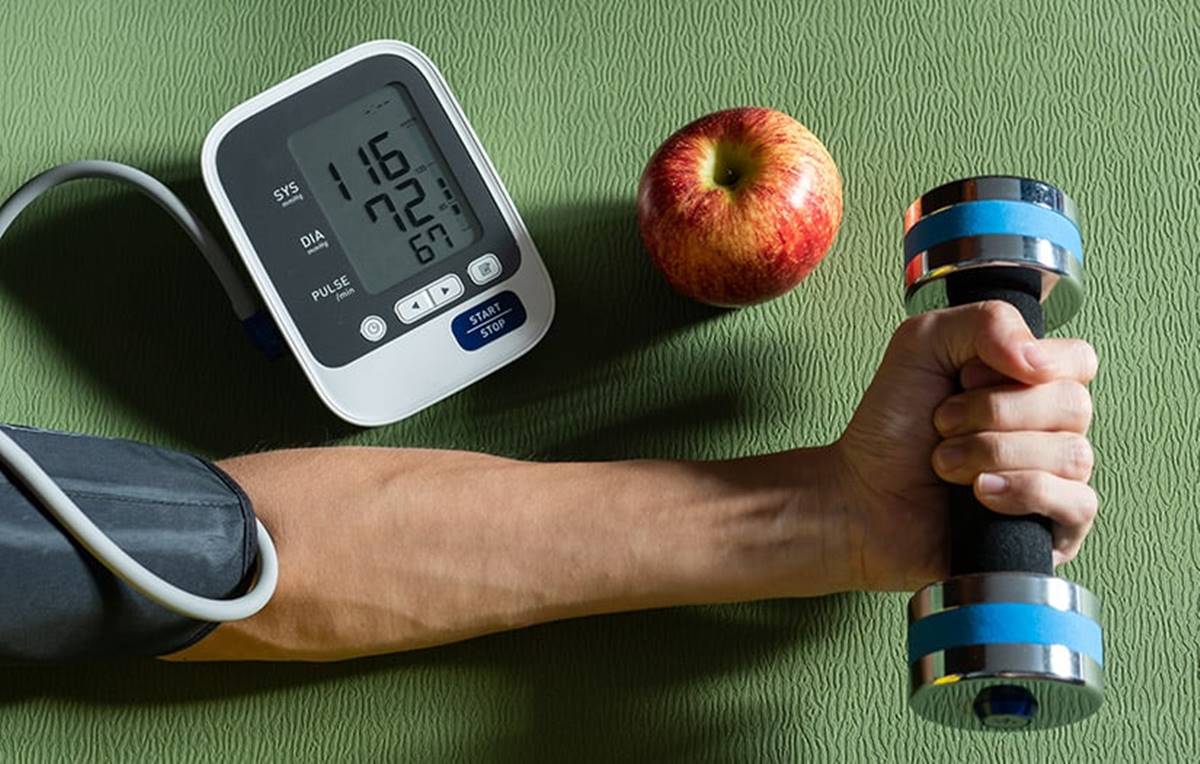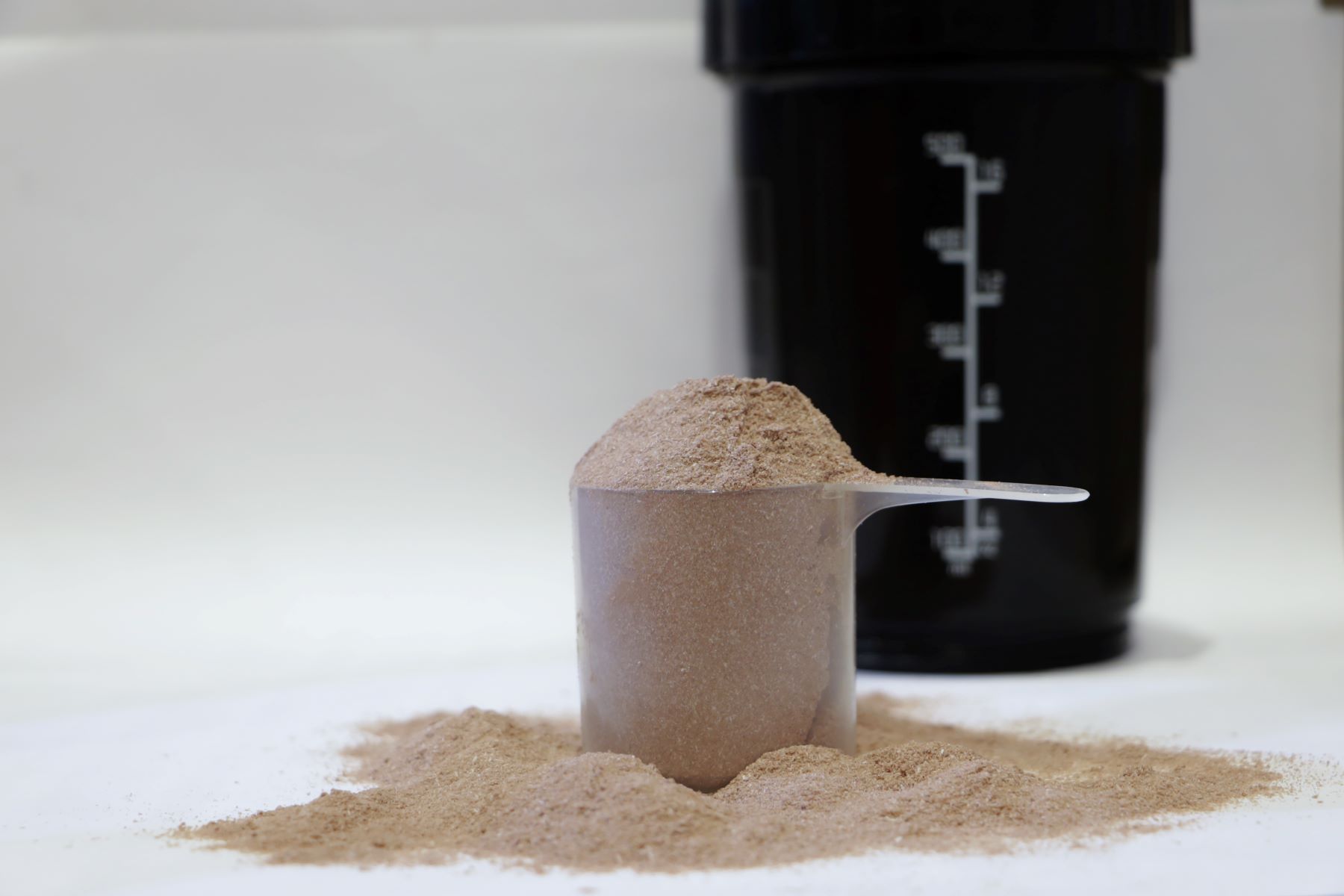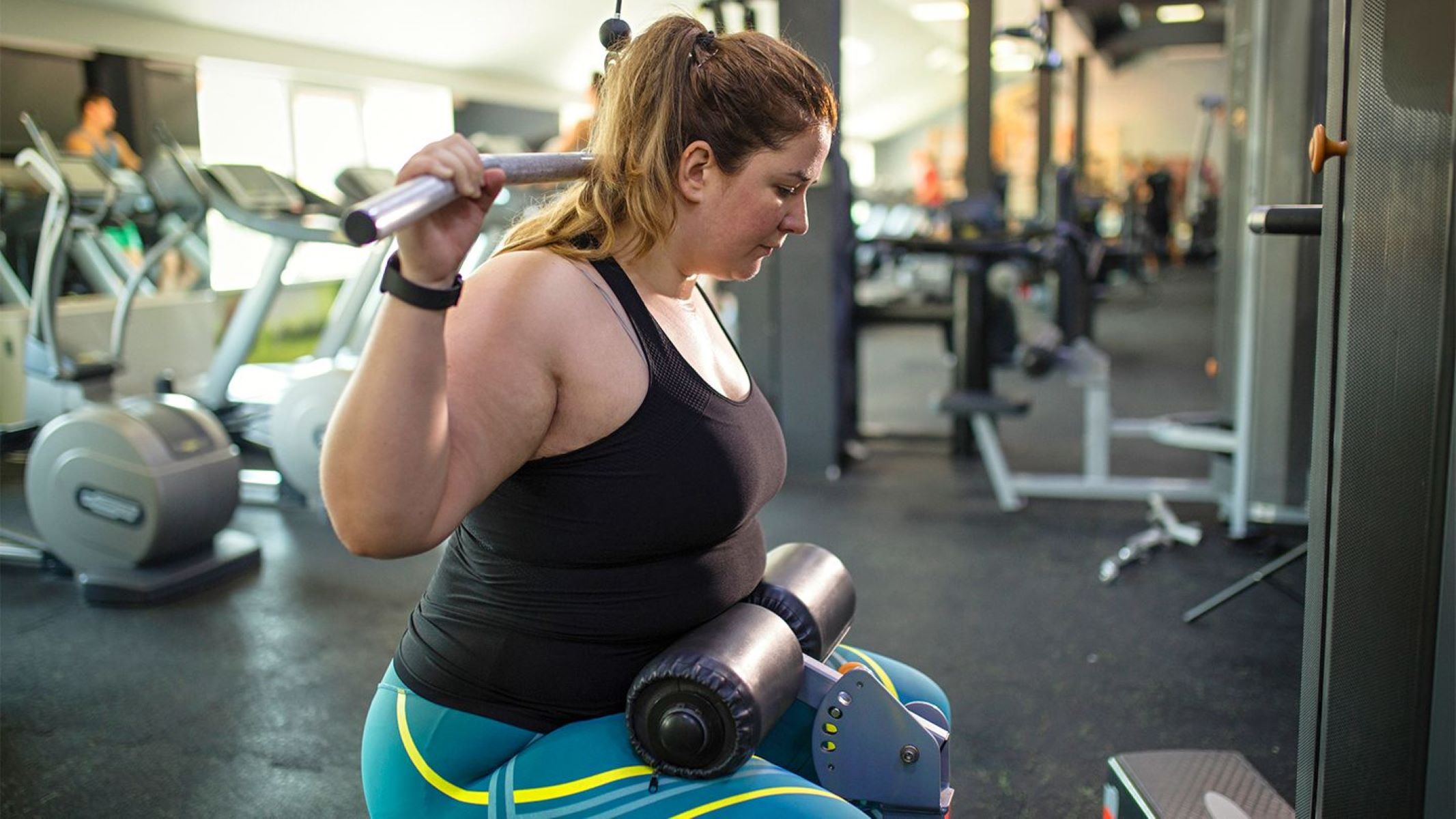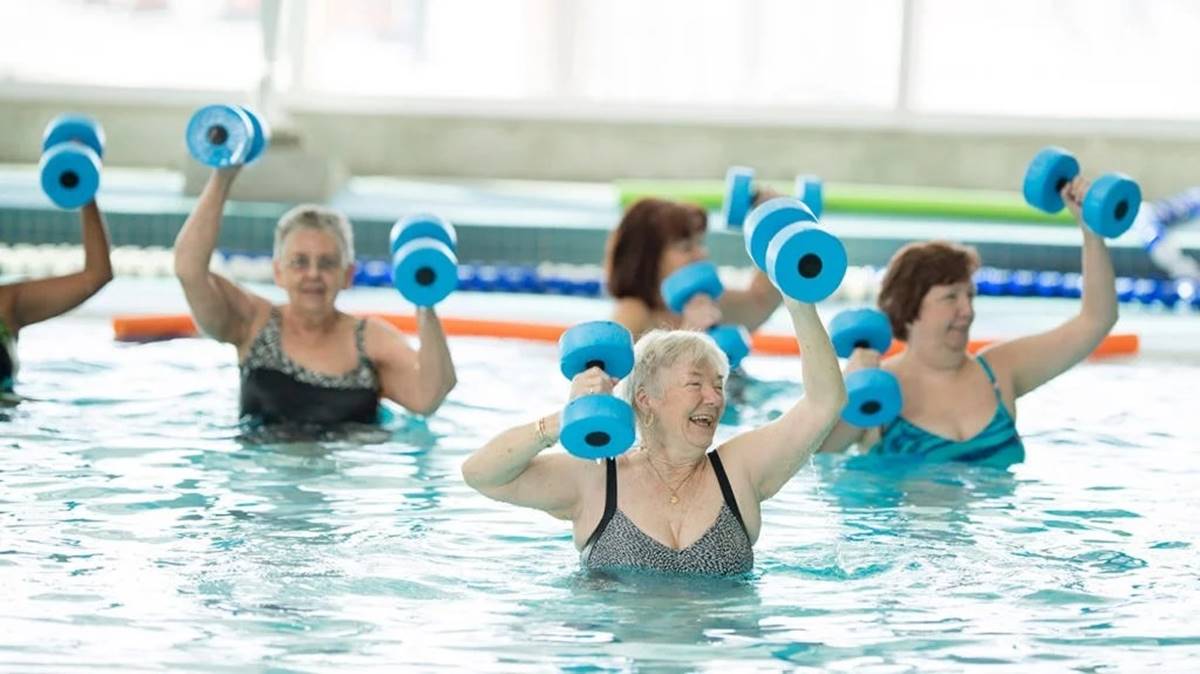Home>Misc>Featured>How Long Does It Take Exercise To Lower Blood Pressure
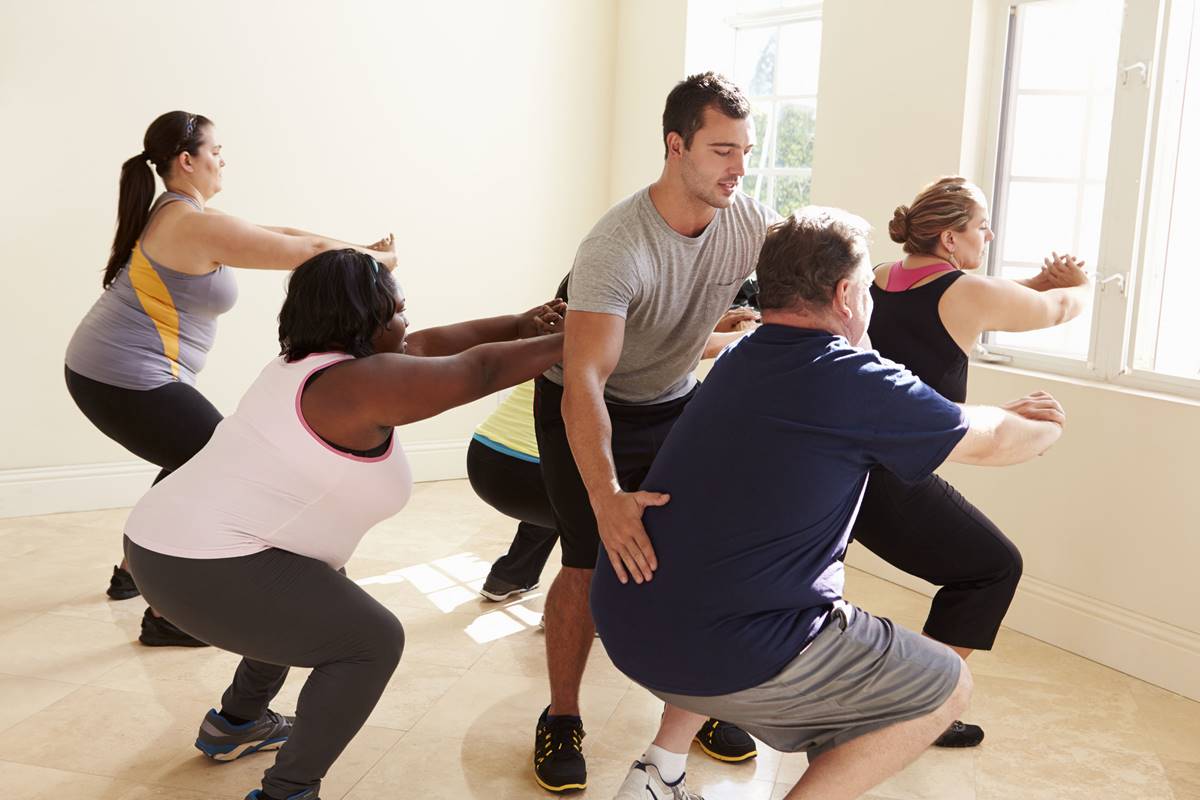

Featured
How Long Does It Take Exercise To Lower Blood Pressure
Modified: January 22, 2024
Discover how long it takes for exercise to lower blood pressure. Get featured tips and insights on reducing hypertension through regular physical activity.
Introduction
Welcome to our comprehensive guide on how exercise can help lower blood pressure. High blood pressure, also known as hypertension, is a common health condition that affects millions of people worldwide. It is a major risk factor for heart disease, stroke, and other serious health issues. However, the good news is that there are lifestyle changes you can make to help manage and lower your blood pressure.
One of the most effective lifestyle changes is regular exercise. Exercise has been shown to have numerous benefits for overall health, and it can play a significant role in managing blood pressure levels. Whether you have been diagnosed with high blood pressure or simply want to maintain a healthy blood pressure range, incorporating exercise into your daily routine is a wise choice.
In this guide, we will explore the relationship between exercise and blood pressure, the factors that can affect the time it takes for exercise to lower blood pressure, the recommended duration and intensity of exercise, different types of exercises for lowering blood pressure, the benefits of regular exercise for blood pressure management, and precautions to consider. By the end of this guide, you will have a solid understanding of how exercise can help lower blood pressure and practical tips for incorporating exercise into your lifestyle.
It is important to note that while regular exercise can be beneficial for most individuals, it is always recommended to consult with your healthcare provider before starting any exercise program, especially if you have pre-existing medical conditions or are taking medications for blood pressure management.
Understanding Blood Pressure
Before delving into how exercise can help lower blood pressure, it is essential to understand what blood pressure is and how it is measured. Blood pressure is the force exerted by blood against the walls of the arteries as the heart pumps it through the circulatory system. It is expressed as two numbers: systolic pressure over diastolic pressure, measured in millimeters of mercury (mmHg).
The systolic pressure represents the force exerted on the artery walls when the heart contracts and pumps blood into the arteries. The diastolic pressure, on the other hand, represents the force between heartbeats when the heart is at rest and refilling with blood. A healthy blood pressure range for adults is typically around 120/80 mmHg, with the systolic reading being the top number and the diastolic reading the bottom number.
When blood pressure consistently exceeds the optimal range, it can lead to hypertension. High blood pressure puts strain on the blood vessels, heart, and organs, increasing the risk of cardiovascular disease, stroke, kidney problems, and other health complications. It is crucial to manage blood pressure levels within a healthy range to maintain good cardiovascular health.
There are several factors that can contribute to high blood pressure, including age, family history, obesity, unhealthy diet, sedentary lifestyle, stress, and certain medical conditions. While some of these factors may be beyond our control, many can be managed through lifestyle modifications, including regular exercise.
Now that we have a basic understanding of blood pressure, let’s explore how exercise can have a positive impact on managing and lowering blood pressure levels.
The Relationship Between Exercise and Blood Pressure
Exercise has long been known to have a positive impact on overall health and can be a powerful tool in managing and lowering blood pressure. When you engage in physical activity, your heart rate increases, causing your blood vessels to dilate and allowing blood to flow more freely. This increased blood flow helps to reduce the resistance against the artery walls, resulting in lower blood pressure readings.
Regular exercise has been shown to have both immediate and long-term effects on blood pressure. After a single exercise session, you may experience a temporary decrease in blood pressure. This reduction can last for several hours and may be particularly beneficial for individuals with hypertension.
However, to achieve the long-term benefits of exercise on blood pressure, it is important to make physical activity a regular part of your routine. Consistency is key. Over time, engaging in regular exercise can lead to a sustained reduction in blood pressure levels, even when you are at rest.
The exact mechanism through which exercise lowers blood pressure is not fully understood, but several factors are believed to contribute to this positive effect. These include:
- Increased production of nitric oxide, a substance that helps relax and dilate blood vessels, leading to improved blood flow.
- Improvement in the efficiency and flexibility of blood vessel walls, enhancing their ability to expand and contract as needed.
- Reduction in circulating levels of stress hormones such as cortisol, which can constrict blood vessels and increase blood pressure.
- Weight management, as regular exercise helps to reduce body weight and body fat, both of which can contribute to high blood pressure.
It is important to note that the impact of exercise on blood pressure can vary from person to person. Some individuals may experience a more significant reduction in blood pressure compared to others. The effectiveness of exercise in lowering blood pressure can also depend on various factors such as age, genetics, current fitness level, and the presence of other medical conditions. Nonetheless, regular physical activity remains one of the most effective lifestyle interventions for managing blood pressure levels.
Factors Affecting the Time Taken for Exercise to Lower Blood Pressure
The time it takes for exercise to lower blood pressure can vary depending on several factors. While regular exercise is generally beneficial for blood pressure management, the rate at which you see results may differ from others. Here are some key factors that can influence the time it takes for exercise to have an effect on blood pressure:
1. Consistency and Duration of Exercise:
The frequency and duration of your exercise sessions play a role in how quickly you may see changes in your blood pressure. Engaging in regular physical activity, ideally most days of the week, is important for achieving lasting results. It is recommended to aim for at least 150 minutes of moderate-intensity aerobic exercise or 75 minutes of vigorous-intensity exercise per week to experience the benefits for blood pressure. Consistency and long-term commitment to exercise are key.
2. Intensity of Exercise:
The intensity of your exercise can also impact the time it takes to lower blood pressure. Moderate-intensity activities like brisk walking, swimming, or cycling can have a positive effect on blood pressure. However, more vigorous exercises like running, high-intensity interval training (HIIT), or competitive sports may yield faster results in reducing blood pressure. It is important to choose exercises that are appropriate for your fitness level and gradually increase intensity to avoid any potential risks.
3. Current Blood Pressure Levels:
Individuals with higher blood pressure readings may experience a more noticeable reduction in blood pressure after starting an exercise program compared to those with slightly elevated levels. However, regardless of your current blood pressure, exercise can provide long-term benefits for managing and maintaining healthy levels.
4. Overall Lifestyle Factors:
Aside from exercise, other lifestyle factors can influence how quickly blood pressure responds to physical activity. These include maintaining a healthy diet, managing stress levels, limiting alcohol consumption, and refraining from smoking. Combining a healthy lifestyle overall will have a greater impact on blood pressure management.
5. Individual Variations and Genetics:
Each person’s response to exercise can be influenced by their genetic makeup and individual variations. Some individuals may be more genetically predisposed to high blood pressure and, therefore, may require more time or additional interventions to see significant changes. It is important to work closely with a healthcare professional to develop a tailored exercise program that suits your specific needs and goals.
Remember that exercise is just one aspect of managing blood pressure. It is important to incorporate it into a comprehensive plan that includes a healthy diet, stress reduction techniques, and regular monitoring of blood pressure levels to achieve optimal results. With commitment and consistency, exercise can be a powerful tool in lowering and maintaining healthy blood pressure levels.
Duration and Intensity of Exercise
When it comes to exercise and its impact on blood pressure, both the duration and intensity of your workouts play important roles. Understanding how to optimize these factors will help you effectively manage and lower your blood pressure. Here’s what you need to know about the duration and intensity of exercise:
Duration of Exercise:
The American Heart Association recommends aiming for at least 150 minutes of moderate-intensity aerobic exercise or 75 minutes of vigorous-intensity exercise per week for overall cardiovascular health. However, when it comes to lowering blood pressure specifically, longer durations of exercise sessions may be more beneficial. Engaging in exercise for longer periods allows your body to experience sustained increases in heart rate, promoting greater improvements in blood vessel health and blood pressure regulation. Aim for at least 30 minutes of moderate-intensity exercise most days of the week, or break it down into shorter sessions if that works better for your schedule.
Intensity of Exercise:
The intensity of your exercise is equally important. Moderate-intensity exercises elevate your heart rate and make you breathe harder, but you can still carry on a conversation comfortably. Examples include brisk walking, swimming, cycling, or dancing. Vigorous-intensity activities, on the other hand, make it challenging to talk without pausing to catch your breath. Running, jogging, HIIT workouts, and playing sports like basketball or soccer fall into this category. Both moderate and vigorous-intensity exercises have been shown to effectively lower blood pressure. However, some studies suggest that higher-intensity exercises may result in a more significant reduction in blood pressure. It’s important to choose activities that you enjoy and are suitable for your fitness level. If you have any concerns, consult with your healthcare provider before starting a new exercise program.
Variety and Combination:
While duration and intensity play key roles, it’s also important to incorporate variety into your exercise routine. Mixing up different types of physical activities, such as aerobic exercises, strength training, and flexibility exercises, can provide additional cardiovascular benefits and contribute to overall fitness. Strength training exercises, like lifting weights or using resistance bands, can help improve muscle strength and reduce the workload on your heart. Additionally, incorporating flexibility exercises, such as yoga or stretching, can help improve circulation and relax your body. Consider working with a fitness professional to develop a well-rounded exercise program that suits your needs and goals.
Gradual Progression:
Regardless of the duration and intensity you choose, it’s important to start at a level that is comfortable for you and gradually increase over time. Sudden, intense exercise without proper preparation can lead to injury or other complications. If you’re new to exercise or have existing health conditions, it’s wise to consult with your healthcare provider or a fitness professional who can guide you on the appropriate duration and intensity for your individual circumstances.
Remember, the goal is to make exercise a sustainable habit. Finding activities that you enjoy and that fit into your lifestyle will increase the chances of sticking to your routine in the long term. By gradually increasing the duration and intensity of your workouts and incorporating variety, you can create an exercise program that effectively lowers blood pressure and contributes to your overall health and well-being.
Types of Exercise for Lowering Blood Pressure
When it comes to lowering blood pressure through exercise, there are several types of physical activities that can be beneficial. Different exercises target various aspects of cardiovascular health, including strengthening the heart, improving blood flow, and enhancing overall fitness. Here are some types of exercises that are particularly effective for lowering blood pressure:
Aerobic Exercises:
Aerobic exercises, also known as cardiovascular exercises, involve continuous and rhythmic movements that elevate your heart rate and increase your breathing. These exercises are excellent for improving heart health and can help lower blood pressure. Some common examples of aerobic exercises include brisk walking, jogging, running, cycling, swimming, and dancing. Engaging in these activities regularly can improve cardiovascular fitness, strengthen the heart, and optimize blood flow throughout the body.
Strength Training:
Strength training exercises involve using resistance to strengthen and condition your muscles. While initially, it may seem unrelated to blood pressure management, strength training can indirectly assist in lowering blood pressure. By increasing muscle mass, you improve your body’s efficiency in burning calories, which helps with weight management—an important factor in maintaining healthy blood pressure levels. Additionally, regular strength training can enhance overall cardiovascular health, leading to better blood pressure control. Examples of strength training exercises include lifting weights, using resistance bands, or performing bodyweight exercises like push-ups, squats, and lunges.
Flexibility and Stretching:
Flexibility exercises may not directly lower blood pressure, but they are essential for overall physical well-being. Incorporating stretching and flexibility exercises, such as yoga or Pilates, into your exercise routine can improve circulation, reduce muscle tension, and promote relaxation. These exercises can help alleviate stress and complement other forms of exercise in managing blood pressure. Stress reduction techniques are beneficial for maintaining healthy blood pressure levels, as stress can elevate blood pressure temporarily or over time.
Interval Training:
Interval training involves alternating between high-intensity exercises and periods of active recovery. This type of exercise has gained popularity for its efficiency and numerous health benefits, including lowering blood pressure. High-intensity interval training (HIIT) has been shown to be particularly effective in reducing blood pressure levels. By pushing your body to work at maximum capacity for short bursts, followed by lower-intensity recovery periods, you can improve cardiovascular fitness, enhance blood vessel function, and potentially lower blood pressure. Examples of interval training include sprint intervals, circuit training, or using exercise equipment like elliptical machines or stationary bikes.
Low-Impact Exercises:
For individuals who may have joint pain or other conditions that limit high-impact activities, low-impact exercises provide a great alternative. These exercises are gentler on the joints while still promoting cardiovascular health. Low-impact exercises include activities such as swimming, water aerobics, cycling, walking, or using an elliptical machine. These exercises can be equally effective in helping lower blood pressure while minimizing the risk of injury or discomfort.
It is important to consult with your healthcare provider before starting any new exercise program, especially if you have pre-existing conditions or concerns. They can provide guidance and recommendations based on your individual needs and help you choose the types of exercises that are safe and suitable for managing your blood pressure.
Benefits of Regular Exercise for Blood Pressure
Regular exercise offers numerous benefits for maintaining and lowering blood pressure levels. By incorporating physical activity into your routine, you can experience the following advantages:
1. Reduction in Resting Blood Pressure:
Engaging in regular exercise has been shown to lead to a decrease in resting blood pressure, even in individuals with hypertension. By consistently exercising, you can lower both systolic and diastolic blood pressure readings, which can significantly reduce the risk of cardiovascular diseases such as heart attacks and strokes.
2. Improved Cardiovascular Health:
Exercise is an effective way to improve overall cardiovascular health. It strengthens the heart muscle, improves its efficiency in pumping blood, and enhances blood vessel function. Regular physical activity can also help improve cholesterol levels, reduce plaque buildup in arteries, and minimize the risk of blood clots. These factors combined contribute to a healthier cardiovascular system and lower blood pressure.
3. Weight Management:
Maintaining a healthy weight is crucial for managing blood pressure. Regular exercise helps with weight loss and weight management efforts by burning calories and increasing metabolism. It also assists in building lean muscle mass, which further aids in calorie expenditure and weight control. Achieving and maintaining a healthy weight can significantly reduce the risk of developing and exacerbating hypertension.
4. Stress Reduction:
Exercise is a potent stress reliever. Physical activity stimulates the production of endorphins, which are natural mood boosters. Regular exercise can help reduce anxiety and depression, improve sleep quality, and enhance overall well-being. By managing stress levels, exercise indirectly helps to lower blood pressure, as high-stress levels can contribute to increased blood pressure readings.
5. Increased Nitric Oxide Production:
Exercise promotes the production of nitric oxide, a compound that helps to relax and widen blood vessels, leading to improved blood flow. This increase in nitric oxide production can enhance blood vessel elasticity and lower blood pressure. By improving blood flow and reducing resistance in the arteries, exercise helps to optimize overall cardiovascular health and reduce the workload on the heart.
6. Prevention of Hypertension:
Regular exercise plays a crucial role in preventing the development of hypertension. Adopting an active lifestyle from a young age and maintaining it throughout life can significantly reduce the risk of developing high blood pressure. Exercise helps to keep blood vessels healthy, lowers the chance of weight gain, and reduces the likelihood of developing other risk factors for hypertension, such as insulin resistance and metabolic syndrome.
It’s important to note that the benefits of regular exercise for blood pressure are enhanced when combined with other healthy lifestyle choices, such as a balanced diet, limited alcohol consumption, and not smoking. Additionally, consistency is key. To maximize the positive effects of exercise on blood pressure, it’s advisable to make physical activity a regular part of your routine.
Lastly, while exercise is generally beneficial for most individuals, it’s important to consult with your healthcare provider before starting any new exercise program, especially if you have pre-existing medical conditions or are taking medications for blood pressure management.
Recommendations for Incorporating Exercise into a Routine
Incorporating exercise into your daily routine is essential for managing and lowering blood pressure. Here are some recommendations to help you establish and maintain a regular exercise habit:
1. Set Realistic Goals:
Start by setting realistic goals that are achievable within your current fitness level and lifestyle. Gradually increase the duration and intensity of your workouts as you build strength and endurance. Setting realistic goals will help you stay motivated and prevent burnout or injuries.
2. Find Activities You Enjoy:
Choose activities that you enjoy and that fit your interests and preferences. Whether it’s dancing, cycling, swimming, or playing a sport, engaging in activities you find enjoyable will make it easier to stick with your exercise routine in the long term.
3. Make it a Daily Habit:
Consistency is key when it comes to exercise. Aim to incorporate physical activity into your daily routine. Find a time that works best for you, whether it’s early morning, during lunch breaks, or in the evenings, and make it a habit to dedicate that time to exercise.
4. Break it Down:
If finding a continuous block of time for exercise seems challenging, divide your workout into smaller sessions throughout the day. For example, you can do two 15-minute walks or three 10-minute workouts spread out during the day. Every bit of movement counts and can contribute to your overall daily physical activity goal.
5. Make it Social:
Exercise with a friend or join a group class to make it more enjoyable and motivating. Having a workout buddy or participating in group activities can provide support, accountability, and camaraderie, making the exercise experience more fun and engaging.
6. Explore Different Types of Exercise:
Don’t limit yourself to just one type of exercise. Incorporate variety into your routine to keep things interesting and to challenge different muscle groups. Explore different activities such as aerobic exercises, strength training, flexibility exercises, and interval training to experience a wide range of physical and cardiovascular benefits.
7. Make Use of Technology:
Utilize fitness apps or wearable devices to track your progress, set goals, and monitor your workouts. These tools can provide valuable insights and motivate you to stay on track with your exercise routine.
8. Listen to Your Body:
Pay attention to your body’s signals and adjust your exercise routine accordingly. Rest when you need to, and don’t push yourself beyond your limits. It’s important to find the right balance between challenging yourself and giving your body the rest it needs to recover.
Remember, the goal is to create a sustainable and enjoyable exercise routine. By incorporating these recommendations into your lifestyle, you can establish a consistent exercise habit that positively impacts your blood pressure levels and overall well-being.
Monitoring Blood Pressure during Exercise
When engaging in exercise to manage and lower blood pressure, it is important to monitor your blood pressure levels to ensure safety and gauge the effectiveness of your workouts. Here are some key considerations for monitoring your blood pressure during exercise:
1. Consult with Your Healthcare Provider:
Before starting any exercise program, especially if you have high blood pressure or other cardiovascular conditions, it is important to consult with your healthcare provider. They can guide you on what blood pressure range is safe for you during exercise and provide recommendations specific to your health needs.
2. Measure Blood Pressure at Rest:
Before beginning your exercise session, take a resting blood pressure measurement to establish a baseline. This will give you an idea of your starting point and help you understand how your blood pressure changes during physical activity.
3. Use Proper Equipment:
Invest in a reliable and accurate blood pressure monitor to track your readings. Automated digital blood pressure monitors are widely available and easy to use at home. Make sure to follow the manufacturer’s instructions for correct usage to obtain accurate readings.
4. Take Regular Readings:
During your exercise session, it may be beneficial to monitor your blood pressure periodically. This can help you keep track of any fluctuations and observe the impact of different exercises and intensities on your blood pressure. However, consult with your healthcare provider for specific recommendations regarding when and how often you should check your blood pressure during exercise.
5. Observe How Exercise Affects Blood Pressure:
Pay attention to how different types of exercise and intensities affect your blood pressure. Some individuals may see an immediate drop in blood pressure during and after exercise, while others may experience a more delayed response. Understanding how your body responds to exercise can help you tailor your workouts for optimal blood pressure management.
6. Establish Safe Ranges for Exercise:
Work with your healthcare provider to determine safe blood pressure ranges for exercise. They may recommend keeping your systolic blood pressure below a certain level (e.g., 180 mmHg) and your diastolic blood pressure below another level (e.g., 100 mmHg) during physical activity. Staying within these ranges will help you exercise safely while avoiding any potential complications.
7. Note Symptoms and Adjust Intensity if Necessary:
During exercise, pay attention to your body’s cues and listen to any warning signs. If you experience symptoms such as chest pain, dizziness, shortness of breath, or a significant increase in blood pressure readings, it may indicate that you need to decrease the intensity of your exercise or take a break. If symptoms persist or worsen, stop exercising and seek medical assistance immediately.
8. Report Any Concerns or Abnormalities:
If you notice consistently high blood pressure readings during exercise or if you have any concerns, report them to your healthcare provider. They can evaluate the specific circumstances and provide further guidance or adjustments to your exercise routine.
Monitoring your blood pressure during exercise is important to ensure that you are exercising safely and effectively. It allows you to make informed decisions about the type, duration, and intensity of your workouts, ultimately leading to better blood pressure management and overall cardiovascular health.
Potential Risks and Precautions
While exercise is generally safe and beneficial for managing blood pressure, it is important to be aware of potential risks and take necessary precautions. Here are some considerations to keep in mind:
1. Consult with Your Healthcare Provider:
Before starting any exercise program, especially if you have high blood pressure or other underlying medical conditions, consult with your healthcare provider. They can evaluate your individual situation, assess any potential risks, and provide guidance on the most suitable types and intensities of exercise for you.
2. Start Slow and Gradually Increase Intensity:
Avoid jumping into high-intensity exercises without proper preparation. Start with moderate-intensity workouts and gradually increase intensity over time. This approach allows your body to adapt and reduces the risk of injury or complications.
3. Be Mindful of Your Physical Limitations:
Pay attention to any physical limitations or discomfort you may have during exercise. If you experience chest pain, dizziness, shortness of breath, or intense fatigue, it may be a sign to modify or discontinue the activity. Listen to your body and respect its limits.
4. Warm-up and Cool-down:
Include a proper warm-up and cool-down before and after exercise. A warm-up prepares your body for physical activity by gradually increasing heart rate and loosening muscles. Cooling down helps bring your heart rate and blood pressure back to normal gradually. These practices can help prevent sudden spikes or drops in blood pressure.
5. Stay Hydrated:
Drink plenty of water before, during, and after exercise to maintain proper hydration levels. Dehydration can affect blood pressure, so it’s important to replenish fluids during your workouts, particularly in hot or humid conditions.
6. Balance Rest and Recovery:
Give your body enough time to rest and recover between exercise sessions. Overtraining or excessive exercise without proper recovery can elevate blood pressure, increase the risk of injuries, and hinder your progress. Listen to your body’s need for rest and incorporate rest days into your routine.
7. Use Proper Form and Technique:
When performing strength training exercises or more complex movements, it’s important to use proper form and technique to reduce the risk of injury. If you’re unsure about the correct form, consider working with a fitness professional who can guide you and ensure you are performing exercises safely and effectively.
8. Be Consistent with Medication and Lifestyle Management:
While exercise can be a valuable addition to blood pressure management, it is not a substitute for medication or other recommended treatments. Be consistent with any prescribed medication, lifestyle changes, and other management strategies that your healthcare provider has recommended.
If you experience any persistent or concerning symptoms during or after exercise, such as severe chest pain, significant shortness of breath, or abnormal heart rhythms, seek immediate medical attention.
By taking precautions, listening to your body, and working closely with your healthcare provider, you can enjoy the benefits of exercise while minimizing potential risks and maximizing your blood pressure management goals.
Conclusion
Exercise plays a vital role in managing and lowering blood pressure, contributing to overall cardiovascular health and well-being. By incorporating regular physical activity into your routine, you can experience a range of benefits, including a reduction in resting blood pressure, improved cardiovascular function, weight management, stress reduction, increased nitric oxide production, and prevention of hypertension.
Understanding the relationship between exercise and blood pressure, as well as the factors that affect the time it takes for exercise to lower blood pressure, allows you to tailor your exercise routine for optimal results. It is important to consult with your healthcare provider to determine safe blood pressure ranges for exercise and to ensure that any potential risks or considerations are addressed based on your individual health needs.
Incorporating a variety of exercises, including aerobic exercises, strength training, flexibility exercises, and interval training, provides the greatest benefits for blood pressure management. It’s important to start slowly, set realistic goals, and gradually increase the duration and intensity of your workouts. Making exercise a daily habit, finding activities you enjoy, and seeking the support of a workout buddy or group can help maintain motivation and consistency.
Monitoring your blood pressure during exercise and being aware of potential risks and precautions are crucial to exercise safely and effectively. Regularly checking your blood pressure, paying attention to your body’s cues, and reporting any concerns or abnormalities to your healthcare provider ensure that your exercise routine is appropriate for your health and well-being.
Incorporating exercise into your lifestyle is just one piece of the puzzle for managing blood pressure. Maintaining a healthy diet, managing stress levels, and adhering to prescribed medications or other management strategies are equally important for overall blood pressure control.
By implementing these recommendations and working closely with your healthcare provider, you can harness the power of exercise as a key strategy for managing and lowering blood pressure, leading to improved cardiovascular health and a better quality of life.





